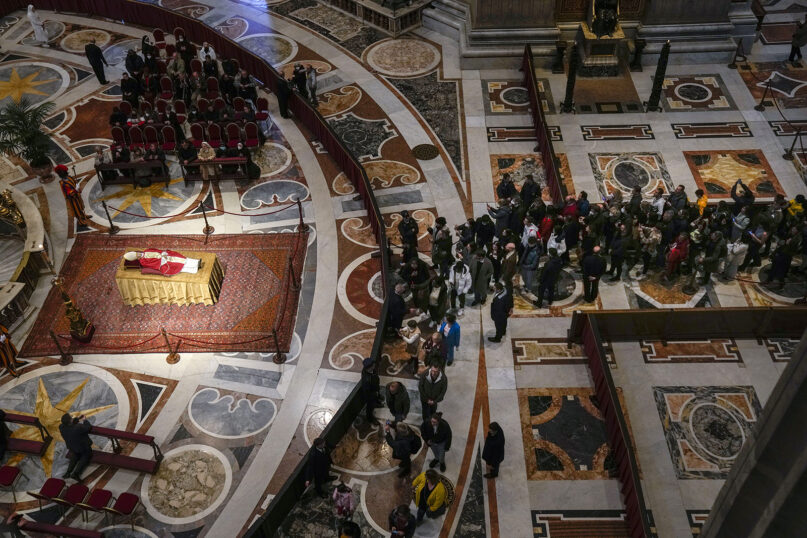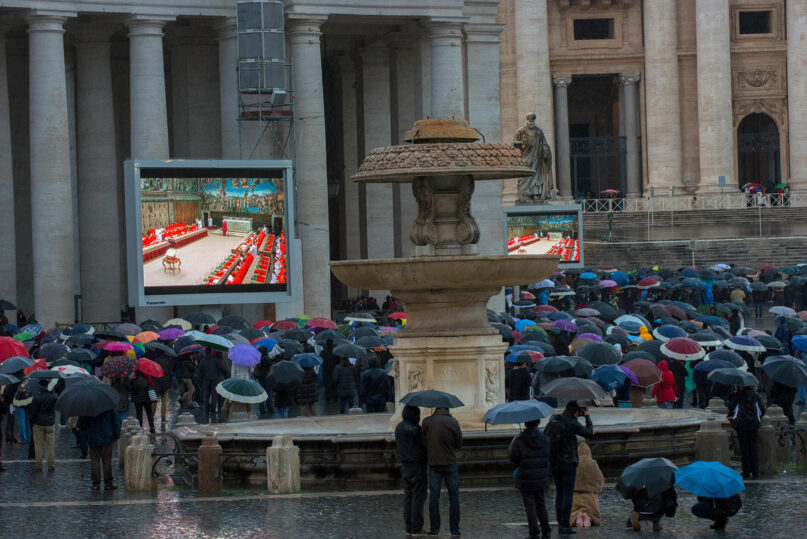
VATICAN CITY (RNS) — For almost 2,000 years, the Catholic Church has honed its rituals that follow the death of a pope, from the traditionally elaborate funeral in St. Peter’s Square to the climactic white smoke above the Sistine Chapel that announces the choice of a successor. Books, TV shows and movies (most recently the Oscar-nominated “Conclave”) have tried to co-opt the drama of this pivotal moment in the church, but they often miss the dignified beauty of how the Vatican says farewell to the outgoing pontiff and hails a new one.
When a pontiff dies, the first person to be notified is the Camerlengo, who oversees the papal household and presides over the church in the period between one pope and the next, known as “sede vacante,” or “empty seat” in English. The current Camerlengo is U.S. Cardinal Kevin Farrell.
But the Camerlengo’s first task is to formally establish that the pope is dead: Calling out the pope’s given name three times in front of other high-ranking clerics. If the pope does not answer, he is proclaimed dead, and the Camerlengo uses a silver hammer to break the pope’s Piscatory Ring, also known as the Ring of the Fisherman, that represents the pope’s temporal power. The room is then locked.
In the past, cardinals and members of the Vatican Curia were known to ransack the papal apartments, which also contain the pope’s will.
Once these rituals are performed, a strict chain of command proceeds to inform Vatican officials, local churches, heads of state and the world of the pope’s death. But in the age of social media, it’s likely that believers and non-believers will have already heard the news of the pontiff’s passing.
According to tradition, the funeral of the pope must take place between four and six days after his death, and a mourning period of nine days is observed. Thousands of Catholic faithful usually gather at the Vatican and St. Peter’s Basilica in these days to pay their final respects to the deceased pope.

FILE – People queue to see the late Emeritus Pope Benedict XVI lying in state inside St. Peter’s Basilica at the Vatican, where thousands went to pay their homage, Jan. 3, 2023. (AP Photo/Antonio Calanni)
Pope Francis simplified and quickened the procedures for a papal funeral in November 2024. Following the death of his predecessor, Emeritus Pope Benedict XVI, Francis ordered that the pope’s body be immediately placed in a simple coffin and displayed in St. Peter’s Basilica. After the vigil, there is the customary funeral Mass.
During this period, which lasts from the pope’s death until up to two weeks, cardinals usually start gathering in Rome. The College of Cardinals is the governing body of the church in the absence of a pope. After Pope John Paul II died, the cardinals’ first act as a body was to attend a Mass in St. Peter’s to ask God for guidance in selecting his successor.
Cardinals also hold meetings in the days leading up to the election of the new pope called general congregations, where they freely discuss their vision for the future of the church, the ideal requisites for a candidate to the papacy and the main challenges facing the religious institution.
Because the cardinals appointed by Francis hail from as far from Rome as Myanmar and Mongolia, places that have never had cardinals before, these meetings will give these more distant prelates opportunities to meet and discuss their perspectives on the church.
Within 15 days of the death of a pope, cardinals will begin the conclave — the word is drawn from the Latin “cum clave,” meaning “with a key,” because they are locked in the Sistine Chapel at the Vatican to vote on the next pope. Cardinals are sworn to not disclose any information about the discussions that occur inside a conclave and to disconnect from all outside information and influence.
A two-thirds majority is needed to elect a pope, and, one by one, the cardinals walk down the aisle toward Michelangelo’s rendition of the Last Judgment to cast their vote. The paper votes are burned, and, depending on the color of the smoke that emerges from the chapel’s chimney, observers from the outside know if the cardinals have successfully selected a successor to St. Peter: Black smoke means more votes are needed, white that a new pope has been chosen.

FILE – People watch giant screens on St. Peter’s Square showing the start of the papal conclave on March 12, 2013, at the Vatican. (RNS photo/Andrea Sabbadini)
The past five conclaves — 1963, August and October 1978, 2005 and 2013 — have lasted between two and three days. According to canon law, any baptized Catholic can be elected pope, and while a lay person or ordinary priest has been chosen on occasion in the church’s millenary history, the pontiff has almost always been a member of the College of Cardinals.
The selected candidate is then asked if he agrees to becoming pope. If he accepts, he is moved to the Room of Tears, a small vestibule near the Sistine Chapel, where he is dressed in the papal cassock for the first time. Its name is due to the strong emotions that the new pope feels once he enters the room.
The new pope is led outside by the dean of the College of Cardinals, currently the Italian Cardinal Giovanni Battista Ré, to the central balcony of St. Peter’s Basilica overseeing the square where faithful will have the chance to catch a glimpse of the new pope for the first time. The deacon says: “Habemus Papam,” meaning “We have a pope,” and introduces the pope by his new name.
